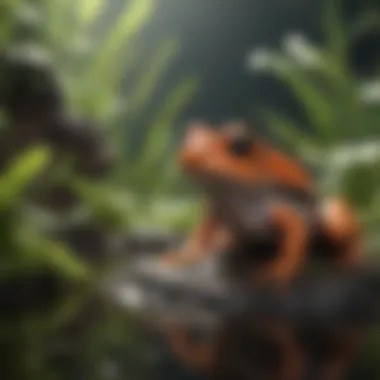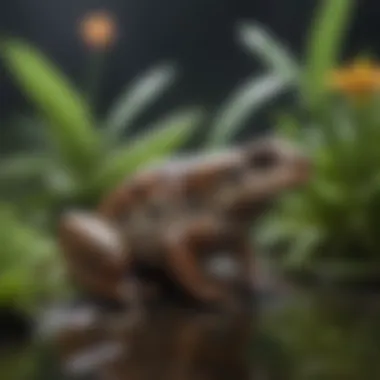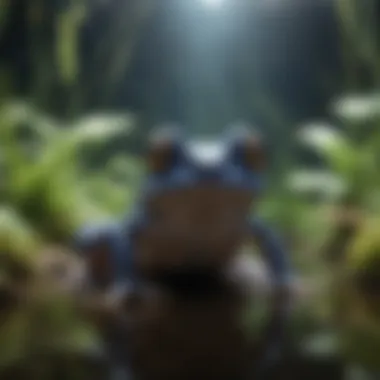Essential Feeding Guide for African Dwarf Frogs


Intro
Feeding African dwarf frogs is a task that requires thoughtful consideration of their unique needs. These amphibious creatures have specific dietary requirements essential for their health and longevity. Understanding what they eat is crucial for pet owners, prospective adopters, and anyone interested in amphibium care. This guide aims to provide in-depth knowledge about feeding African dwarf frogs, covering necessary nutritional components, common food types, and practical feeding tips.
In diving into the intricacies of frog nutrition, readers will uncover common misunderstandings about their feeding habits. This includes exploring both commercial options and homemade diets that can offer substantial health benefits. By ensuring a balanced intake and avoiding dietary pitfalls, frog owners can enhance the quality of life for their beloved pets. The exploration into the dietary needs of these frogs will also highlight the relevance of proper feeding strategies in promoting their overall well-being.
Pet Care and Grooming
Importance of Regular Care
To ensure the well-being of African dwarf frogs, regular care is vital. This includes not only feeding but also maintaining clean habitats and monitoring water quality. Frogs are sensitive to their environment, and neglecting routine checks can quickly lead to health issues. Regular care extends to ensuring that their living space mimics their natural habitat as closely as possible.
Grooming Techniques by Pet Type
Grooming for African dwarf frogs is less about aesthetics and more about health. Regular checks for skin quality and proper living conditions can help prevent disease. Frogs do not require traditional grooming like fur-bearing pets, but observing their skin for discoloration or growths is essential. Ensure that your hands are clean when handling them to prevent transferring harmful chemicals.
Tools and Products Recommendations
Several tools and products can aid in the upkeep of African dwarf frogs:
- Aquarium Test Kits: Assessing water quality.
- Water Conditioner: To remove harmful chemicals from tap water.
- Aquarium Vacuum: To clean gravel and substrate.
- Net: For moving frogs safely.
Using the right products significantly contributes to the well-being of your amphibious pets.
Seasonal Care Tips
Seasonal changes can impact the environment in which your frogs live. Owners should be vigilant during extreme temperatures. In winter, ensure that the water remains warm, ideally between 72°F to 78°F. In summer, avoid direct sunlight that can heat the water excessively. Adjustments may also be necessary for feeding habits as frogs can become less active in colder months.
Health and Nutrition
Understanding Pet Nutrition
Nutritional knowledge is key for pet owners. African dwarf frogs require a mix of proteins, vitamins, and minerals to thrive. Their diet should consist of small bites that are easy to ingest; common options include specially formulated frog pellets, freeze-dried bloodworms, and brine shrimp. Understanding these dietary components can help avoid malnutrition, which can lead to serious health issues.
Common Health Issues by Species
Several health issues are prevalent among African dwarf frogs, often resulting from improper care or nutrition. Some of the issues include:
- Bacterial Infections: Caused by poor water quality.
- Parasites: Can result from contaminated food sources.
- Skin Diseases: Often linked to stress or unsuitable environmental conditions.
Preventive Care and Regular Check-Ups
Regular health check-ups are a proactive measure for any frog owner. Observing eating habits and overall activity can indicate health status. Consulting a veterinarian familiar with amphibians can be beneficial. Establishing a routine will help catch any potential health issues before they escalate.
Food and Dietary Advice
Providing a balanced diet is crucial. Avoid feeding African dwarf frogs food larger than their mouths. Maintain a regular feeding schedule, typically once or twice daily, ensuring food is consumed within a few minutes to prevent water quality degradation. Consider rotation of food types to provide varied nutrition.
Proper diet significantly impacts African dwarf frogs' health and vitality.
Resources and Community Engagement
Recommended Books and Websites
To deepen your understanding, several resources can help:
- "Frogs and Toads: A Complete Pet Owner's Manual" by Mark A. A. Price: An insightful book on amphibian care.
- Wikipedia (en.wikipedia.org): A great source of general knowledge about frog species.
- Britannica (britannica.com): Offers articles on the biological aspects of amphibians.
Forums and Groups for Pet Owners
Engaging with online communities provides support and shared experiences. Websites like Reddit can serve as platforms for exchanging ideas and advice with fellow frog owners.


Finding Local Services and Classes
Many local pet stores offer care classes that may include frog husbandry. Investigating resources nearby can help enhance your understanding and capabilities as a frog caretaker.
Encouraging Community Sharing and Contributions
Participating in discussions and sharing experiences benefits everyone in the pet owner community. Your input can enrich others’ understandings of caring for these frogs.
By recognizing the essential elements of proper care, nutrition, and community engagement, novice and seasoned frog owners alike can ensure the welfare of their African dwarf frogs.
Understanding African Dwarf Frogs
Understanding African Dwarf Frogs is essential for their care and well-being. These small amphibians are popular pets due to their unique characteristics and relatively easy maintenance. However, providing suitable nutrition is a key factor in ensuring their health. By comprehending their biology, habitat, and natural dietary preferences, owners can make informed choices about how to feed them effectively.
Biology and Habitat
African Dwarf Frogs are a species known for their adaptable nature and personality. They typically grow to about 2 to 3 inches in length and possess a soft, amphibious body. Their skin is often mottled with brown, green, or beiged hues, providing them with natural camouflage in their aquatic environments. They spend most of their lives submerged in water, preferring temperatures between 72 to 78 degrees Fahrenheit and pH levels around neutral.
In the wild, African Dwarf Frogs inhabit slow-moving or still waters like ponds and marshes across Africa. Their environments provide a diverse array of food sources, from small insects to plant matter. Understanding this habitat is crucial because it helps owners replicate similar conditions in aquariums, thereby promoting healthier and more active frogs.
Natural Diet in the Wild
In their natural habitat, African Dwarf Frogs primarily consume a varied diet that consists of small aquatic creatures. They are opportunistic feeders, meaning they adapt their diet depending on food availability. Insects, small crustaceans, and tiny fish are common in their wild diet. This range of food items provides the frogs with essential nutrients, allowing them to thrive in their ecosystem.
Observing their behavior in natural settings also highlights their foraging instinct. African Dwarf Frogs often hunt and scavenge for food, showcasing their adaptability. This natural approach to feeding contrasts with the more controlled feeding methods commonly used in captivity. Therefore, recognizing their wild diet patterns is significant. It guides pet owners in developing a balanced feeding regimen that aims to simulate the variety and nutrient richness found in their natural environment.
The key to healthy African Dwarf Frogs lies in replicating their natural feeding patterns as closely as possible.
By understanding their biology and natural diet, owners can craft a well-rounded feeding plan, ensuring the frogs receive all necessary nutrients for their development and longevity.
Nutritional Requirements
Understanding the nutritional requirements of African dwarf frogs is essential for maintaining their health and well-being. These small amphibians are sensitive to their diet, and ensuring they receive adequate nutrition directly impacts their growth, vitality, and overall quality of life. The right balance of nutrients plays a critical role in promoting immune function, proper development, and reproductive success. This section will delve into essential nutrients, the relevance of water quality, and how both influence the feeding practices for these frogs.
Essential Nutrients
Proteins
Proteins are a fundamental part of the diet for African dwarf frogs. They serve as building blocks for tissues, enzymes, and hormones. The presence of proteins in their diet supports growth and repair of body cells. Common protein sources include commercially prepared pellets and high-quality live foods.
A key characteristic of proteins is their amino acid profile. Amino acids are necessary for various physiological functions. For African dwarf frogs, a diet rich in protein contributes to greater energy levels and improved durability. However, while proteins are essential, they should be provided in moderation. Overloading on protein can lead to excess waste, which negatively affects water quality.
Carbohydrates
Carbohydrates serve as a source of energy for African dwarf frogs. While frogs primarily derive their energy from proteins and fats, carbohydrates can provide supplementary energy necessary for their active lifestyle. Foods such as certain vegetables may offer carbohydrate content beneficial for maintaining energy levels.
The ability of carbohydrates to break down into simpler sugars allows easy absorption. However, the type of carbohydrates offered is significant. Low-quality carbohydrates can lead to digestive issues, while balanced sources support consistent energy release without drastic fluctuations.
Vitamins and Minerals
Vitamins and minerals are crucial for the overall metabolic processes in African dwarf frogs. These nutrients regulate biological functions and maintain structural integrity of bones and tissues. For example, calcium and potassium are vital for muscle contractions and maintaining bone health.
The key characteristic of vitamins and minerals is their micronutrient role. They are needed in smaller quantities but are equally important as primary macronutrients. Vitamin deficiencies can lead to health problems such as stunted growth or weakened immune response.
Incorporating a variety of foods ensures a comprehensive intake of these necessary nutrients, thereby promoting their physiological health. A balanced dietary approach reduces deficiencies and supports a robust immune system.
Water Quality and Its Impact on Diet
Water quality significantly influences the dietary habits of African dwarf frogs. Poor water conditions can adversely affect appetite and overall health. Missing essential parameters such as pH and ammonia levels in tank water can lead to stress and, consequently, digestive issues.
In addition to maintaining clean water, adequate oxygen levels and temperature regulation are vital for their metabolic processes. A well-managed aquatic environment enhances feeding effectiveness and absorption of nutrients. Regular water testing and changes are necessary to avoid detrimental bacteria buildup, ensuring that the frogs thrive and are more inclined to eat well, thus supporting their nutritional requirements.


Types of Food for African Dwarf Frogs
Understanding the types of food available for African dwarf frogs is crucial for their health. Different food types provide various nutritional profiles, ensuring that their dietary needs are met. In this section, we will explore commercial food options, homemade food recipes, and the role of live food.
Commercial Food Options
Pellets
Pellets are a popular choice among pet owners for feeding African dwarf frogs. They are specially formulated to meet the nutritional needs of these frogs. A key characteristic of pellets is their balanced composition, which includes proteins, fats, and vitamins. This makes them a convenient option for many owners. The unique feature of pellets is their nutrient density, providing a comprehensive diet in a small form.
However, one disadvantage is that some frogs might be hesitant to eat pellets, especially if they are not used to this food type. It is important to monitor their eating habits and adjust accordingly.
Flakes
Flakes offer another commercial option for feeding. They are easy to find and provide a variety of nutrients suitable for African dwarf frogs. The key characteristic of flakes is their floating nature. This allows frogs to easily catch them as they swim to the surface.
An advantage of flakes is their appeal to various frogs. However, they might dissolve quickly in water, leading to waste if not consumed in a timely manner, so proper portioning is necessary.
Freeze-Dried Foods
Freeze-dried foods are gaining popularity among frog owners. These foods retain many nutrients while being lightweight and easy to store. Their key characteristic is their long shelf life, allowing for extended use without spoilage.
A unique advantage is their palatability; many frogs enjoy the taste of freeze-dried options. Nonetheless, they can lack some moisture compared to fresh or live food, so it's wise to supplement their diet with other food types to prevent dehydration.
Homemade Food Recipes
Vegetable Options
Vegetable options can play an important role in a frog's diet. Many owners choose to include vegetables because they are rich in vitamins and minerals. Carrots, spinach, and zucchini are beneficial choices, as they provide essential nutrients.
The key characteristic of vegetable options is their accessibility. They are readily available and inexpensive. However, a disadvantage is that not all frogs may readily accept vegetables. It may take time and persistence to introduce them to these foods.
Animal Protein Sources
Animal protein sources are crucial for African dwarf frogs. Foods like cooked fish or earthworms provide essential proteins that frogs need for growth and maintenance. The key characteristic of animal protein sources is their high protein content, which is vital for frogs’ health.
A major advantage of feeding animal protein is their attractiveness to frogs, as they often entice frogs to eat. An important caution is to ensure these sources are prepared properly, as raw or unclean food can lead to health issues.
Live Food Considerations
Daphnia
Daphnia are tiny crustaceans that are highly nutritious. They are a natural food source for African dwarf frogs and provide a rich source of protein. The key characteristic of daphnia is their movement. This often stimulates the frogs’ hunting instincts, making feeding more engaging.
One major benefit is that daphnia closely mimics a frog's natural diet. However, they require frequent sourcing to keep supply constant, which may not be feasible for all owners.
Bloodworms
Bloodworms are another excellent option for live food. They are rich in protein and often loved by frogs. The key characteristic of bloodworms is their high-fat content, providing energy for active frogs.
A significant advantage of bloodworms is their frequency in pet stores. However, they should be fed in moderation, as their fat content can lead to obesity if overfed.
Feeding Practices
Feeding practices play a critical role in maintaining the health and vitality of African dwarf frogs. Understanding the ideal methods for feeding these small amphibians ensures they receive the right nutrients without falling prey to common dietary pitfalls. The frequency of feeding, portion sizes, and monitoring behavior all contribute to a balanced diet that promotes longevity and well-being.
Feeding Frequency and Portion Sizes
African dwarf frogs have unique feeding habits that need careful consideration. Ideally, these frogs should be fed once or twice daily. This regular feeding schedule helps mimic their natural foraging behavior. By offering food at consistent intervals, it allows the frogs to establish a routine, which can lead to healthier feeding behavior.
Portion sizes are equally important. Overfeeding can lead to obesity, which can cause various health issues. A general rule is to supply food that is equal to the size of their head. If they cannot consume the food within a few minutes, you may be offering too much. The goal is to ensure they eat all their food without leaving leftover pieces in the tank, as decomposing food can affect water quality. This leads to complications such as ammonia spikes, which can harm the frogs.


- Feed small amounts daily.
- Observe the size of the frogs when determining portion sizes.
- Remove uneaten food promptly.
Monitoring Feeding Behavior
Observing the feeding behavior of African dwarf frogs is essential for identifying any potential issues. Healthy frogs are usually active during feeding times, eagerly approaching the food. If you notice lethargy or disinterest in food, it could indicate a health problem. Regular monitoring allows you to catch early signs of illness or stress.
Pay attention to their eating patterns. If a frog consumes food readily one day and shows less enthusiasm the next, investigate possible reasons. This may include stress, changes in water quality, or illness. Understanding these behaviors helps you adjust feeding practices accordingly. A varied diet could also stimulate their interest. Incorporating different foods may lead to more consistent feeding behaviors.
A few key practices for monitoring include:
- Watch for activity levels at feeding time.
- Maintain a consistent feeding schedule.
- Be aware of any unusual behavior or changes in appetite.
Regularly observe and adapt to your frog's needs, ensuring a healthy and harmonious aquatic environment for them.
Common Nutritional Pitfalls
Understanding the common nutritional pitfalls is essential for maintaining the health of African dwarf frogs. These amphibians, while resilient, can develop health issues if not fed correctly. Many owners may unknowingly contribute to their pets' problems by failing to recognize the subtle signs or the implications of poor dietary choices.
A balanced diet is not just about providing food; it also involves understanding the factors that can lead to health complications. Owners must be aware of overfeeding or underfeeding and the consequent risks. Addressing these issues helps create a healthier environment conducive to the frogs' wellbeing.
Overfeeding and Its Consequences
Overfeeding is a prevalent issue among pet owners, particularly with African dwarf frogs. These creatures may seem eager eaters, and it can be tempting to provide them additional food. However, this can lead to significant health problems. Overfeeding can cause obesity, which puts additional strain on their organs, especially the liver and kidneys.
When frogs are overfed, uneaten food can also contaminate the tank, leading to water quality issues. This, in turn, affects overall water conditions and can result in toxic environments for the frogs. Signs of overfeeding include lethargy and difficulty moving.
To prevent this, it is crucial to follow recommended feeding guidelines. Rather than offering excessive portions, owners should focus on a measured approach.
Nutritional Deficiencies and Disorders
Conversely, a lack of necessary nutrients can lead to serious deficiencies and disorders. African dwarf frogs require a balanced intake of proteins, vitamins, and minerals. Absent nutrients can cause developmental issues, compromised immune systems, and prevent proper growth.
Common deficiencies to note include a lack of proteins, which can lead to stunted growth and weakened muscles. Similarly, insufficient vitamins, especially A and D, can lead to skin and bone health issues. Moreover, calcium deficiency can result in improper bone formation, ultimately affecting the frog's overall mobility.
To avoid these issues, it’s vital to ensure diverse food sources, incorporating both commercial and homemade options. Regular monitoring of the frog's health and behavior is beneficial, allowing for timely adjustments to their diet when necessary. Maintaining a focus on balanced nutrition will prevent pitfalls and promote longevity in African dwarf frogs.
"A well-balanced diet is key to avoiding nutrition-related health issues, ensuring your African dwarf frog thrives."
Special Dietary Considerations
The dietary needs of African dwarf frogs are not static. They can change based on various factors such as breeding season and age. Understanding these special considerations is crucial for maintaining the health of your frogs. Proper attention to diet at different life stages can significantly impact their well-being and longevity.
Diet During Breeding Season
During the breeding season, which typically occurs in warmer months, dietary requirements for African dwarf frogs may shift. Providing a nutrient-dense diet becomes important at this time. Female frogs, in particular, require more protein to support egg production. Foods rich in protein like bloodworms and high-quality frog pellets should be prioritized.
Moreover, it's important to monitor their overall intake. Overfeeding females during this time can lead to health issues. This requires a careful balance in feeding practices. In this phase, considering supplements, such as vitamins, can also help ensure optimal reproductive health.
Age-Related Dietary Needs
Age plays a significant role in the dietary requirements of African dwarf frogs. Juvenile frogs need a higher protein diet to support growth and development. Small, protein-rich foods such as daphnia and finely crushed pellets should be offered regularly. As they reach maturity, the focus can shift to a more balanced diet with a mix of protein and plant matter.
For older frogs, it’s critical to adjust their diet to accommodate any changes in metabolism. Foods that are easier to digest, combined with regular monitoring of their health, can help prevent any age-related issues.
Culmination
In concluding this guide on the dietary needs of African Dwarf Frogs, it is essential to reiterate the significance of a well-balanced diet. This extends beyond mere sustenance; it encompasses the overall health and longevity of these fascinating amphibians. By emphasizing a diverse range of food types, including commercial options and homemade recipes, owners can ensure their frogs receive vital nutrients necessary for growth and vitality.
Summarizing the Importance of a Balanced Diet
A balanced diet for African Dwarf Frogs includes a careful mix of proteins, carbohydrates, vitamins, and minerals. Each element plays a crucial role in promoting a frog's overall well-being. Protein is vital for growth and development, while carbohydrates provide necessary energy.
Moreover, vitamins and minerals support essential bodily functions, ensuring optimal immune response and preventing nutritional deficiencies.
Key Takeaways:
- A varied diet helps to prevent boredom in feeding and encourages more natural foraging behaviors.
- Proper nutrition reduces the risks of health issues often seen in frogs, such as obesity or malnutrition.
- Observing your frogs' dietary habits can provide insight into their health and adaptability to changes in diet.
By remaining mindful of these aspects, pet owners can significantly enhance the life quality of their African Dwarf Frogs. Understanding their unique dietary needs facilitates responsible ownership and fosters an enriching environment. This guide serves as a comprehensive resource, helping increase awareness about the essential role of nutrition in amphibian health.















